How to choose fuel for a biofireplace: a comparative review of fuel types + analysis of popular brands
A fireplace with a “bio” prefix works great in city apartments. The device does not require permits, a chimney, or a fuel storage room.The impressive unit does not process traditional firewood. So what does it need to burn? Agree, you need to understand the issue if you plan to acquire an environmentally friendly fireplace.
We will tell you in detail how to correctly select fuel for a biofireplace. Here you will find out what kind of fuel is required for its stable and safe operation, what are the advantages of its use. The article presented to your attention will introduce you to popular brands of fuel.
We present to your attention a detailed description of the types of fuel used to start and maintain fire in biofireplaces. A recipe for self-cooking the simplest fuel is given and carefully analyzed. Recommendations are given for refueling and lighting the fireplace, compliance with which will prevent the occurrence of threatening situations.
The content of the article:
Types of environmentally friendly biofuels
The prefix “BIO” is now often added to labels based on the rules of successful marketing. Issues of preserving the environment and cleanliness are in fashion today throughout the planet. Bio-products, bio-cosmetics, bio-based detergents, purification and bio-energy stations and even bio-toilets. It also came to fireplaces and fuel for them.
Structurally biofuel fireplaces equipped with a standard burner and liquid fuel tank. Adjustment of the flame size and fuel combustion rate is carried out using a damper.
If it is completely closed, then the fire in the biofocus simply goes out by itself.In general, a bio-fireplace is a great way to heat a room and add a touch of coziness to it from the glow of the “bonfire”.
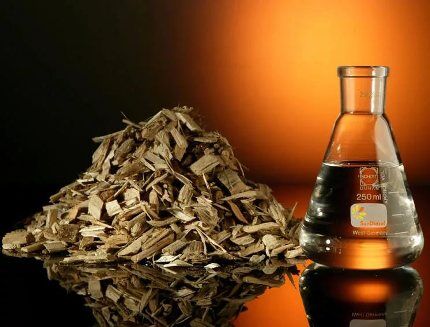
Obtaining biofuel for such a fireplace involves the use of renewable natural resources, environmentally friendly technologies and raw materials during production. Plus, burning it should not produce harmful emissions into the atmosphere. Humanity cannot yet survive without combustible fuel. But we can make it less harmful.
Exists three types of biofuels:
- Biogas.
- Biodiesel.
- Bioethanol.
The first option is a direct analogue of natural gas, only it is not extracted from the bowels of the planet, but is produced from organic waste. The second is made by processing various oils obtained by squeezing oilseed plants.
As such, the fuel for biofireplaces is the third option - bioethanol. Biogas is mainly used to generate heat and electricity on an industrial scale, while biodiesel is more suitable for automobile internal combustion engines.
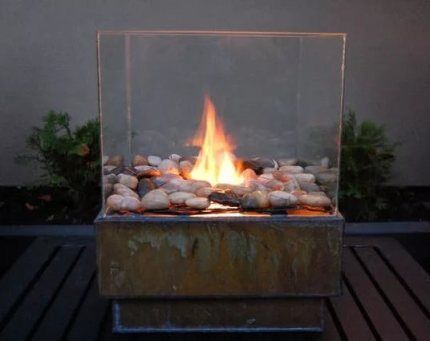
Home fireplaces are most often fueled with bioethanol based on denatured alcohol. The latter is made from sugar (cane or beet), corn or starch. Ethanol is ethyl alcohol, which is a colorless and highly flammable liquid.
But most importantly, when burned, it does not emit odors, carbon monoxide and soot.Simply an ideal option for city apartments, in which it is almost impossible to install a chimney pipe.
For those who wish make a bio fireplace A step-by-step guide will help you with your own hands, which we recommend that you read.
Fuel for operating a biofireplace
The use of smokeless bioethanol allows you to do without an exhaust pipe, into which up to 60% of the thermal energy generated in the furnace often goes. All heat obtained as a result of burning fuel remains in the room.
From this point of view, the efficiency of a biofireplace is much higher than that of a conventional fireplace. The heat transfer of the biofocus reaches 95%. Plus, the flammable liquid itself has a higher calorific value than wood. WITH calorific value Our recommended article will introduce you to various types of fuel.

When burned, bioethanol decomposes into steam and carbon monoxide (“bubbles in soda”), releasing quite large volumes of heat. No carbon monoxide or soot. The entire process occurs without toxic emissions or unpleasant aroma.
Carbon dioxide is harmless in small quantities. It is even used in the food industry. However, you should not refuse regular ventilation.
The resulting steam also slightly humidifies the air in a room with a burning bio-fireplace. The same electric radiator only dries it out. In this respect, the eco-fireplace outperforms all heating devices powered by electricity or coolant. But it produces less heat and as a result is not considered a heating device.
Composition and features of fuel
Biofuels are made up of more than just alcohol. It contains various additives that change the color of the flame, add odors and make the liquid unsuitable for “accidental” ingestion. Moreover, the last point concerns not only attempts to drink alcohol by adults.
All manufacturers add Bitrex, which has a very bitter taste, to bioethanol. This almost completely eliminates poisoning from liquid fireplace fuel for children, who are able to find and try anything. When trying to drink ethanol with Bitrex, the child will at least spit it out due to the bitterness in the mouth. And often such drinking causes vomiting.
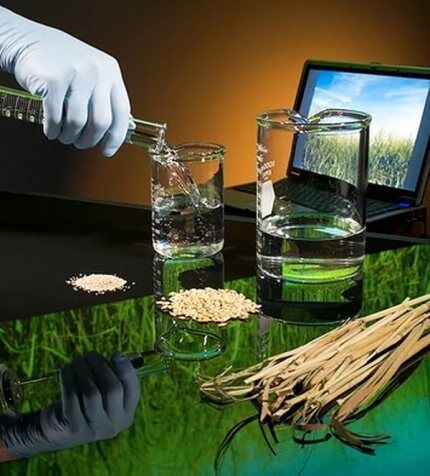
The fuel for biofireplaces contains:
- Ethyl alcohol (95%).
- Water (4%).
- Solvent methyl ethylene (about 0.5%).
- Additives for odor and color (about 0.5%).
- Denaturing bitrex (about 0.01%).
Pure biofuel does not produce any odors when burned. But there are fireplace liquids that have specially added fragrances. When burned in a bio-fireplace, such fuel can release the aroma of pine needles, coffee, birch or maple firewood, etc.
But it is worth remembering that fragrance requires more intensive ventilation. You will have to ventilate the room more often, otherwise you may get tired of an overabundance of aromas. Everything should be in moderation.
There are also variations of flammable liquids with different flame colors (red, orange, green). To choose the right biofuel, you just need to carefully read the label on the bottle.
The full composition, additives, heat transfer, and flame shade are always spelled out there.And if you need a “crackle of firewood,” then you need to look for an option with sea salt. It crackles slightly when burning, creating the illusion of using real logs.
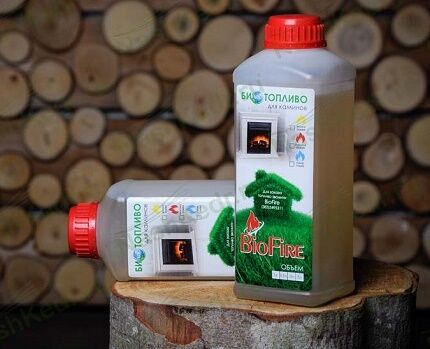
Advantages and fuel consumption
Among the many advantages of using biofuels, the following should be highlighted:
- absence of carbon deposits and ease of cleaning of burner elements;
- high safety regarding the occurrence and spread of fire;
- the ability to control the intensity of fuel combustion;
- almost one hundred percent heat transfer;
- humidification of room air due to the release of water when ethanol is heated;
- Convenient storage of liquid fuel in closed bottles.
The biofireplace itself can be installed in any part of the room. It is light and mobile. If necessary, such a fireplace can be moved to another room, like a regular electric heater.
Only the biological hearth does not have wires and it does not need to arrange a small woodpile of firewood nearby in order to constantly add firewood to the firebox. Fill the tank, light the burner, adjust it, and then sit back and enjoy the warmth and sight of the flame.

When one liter of liquid bioethanol is burned, about 3.5–6 kWh of thermal energy is released. The tank in most fireplace models is designed so that the flame can be maintained on one fill for at least 4 hours without human intervention.
Some modifications of such equipment can work for up to 30 hours. But here a lot depends on the height and width of the flame.A single tongue is one thing, and a wall of fire in a wide hearth is another.
Pouring biofuel into the fireplace tank is carried out only with the burner extinguished. You must first put out the fire and wait for the fireplace elements to cool (at least 15 minutes), and only then add flammable liquid. Otherwise, it may spill and catch fire in the wrong place.
Fuel consumption in most biofireplaces is around 0.35–0.5 liters/hour. To ignite it, a special metal lighter is used. It is strictly forbidden to use matches, paper or other flammable materials for this purpose.
Review of popular brands
Biodiesel for automobiles is mainly produced in America (USA, Canada and Brazil), as well as India, China and Europe. This is often presented as concern for the environment and increased use of alternative energy sources.
But there is one caveat - to produce large volumes of biodiesel, large volumes of organic matter (corn, rapeseed, sugar cane) are required. However, large-scale cultivation of these crops consumes a lot of water and, again, fuel for agricultural machinery.
The output result is quite ambiguous. It’s one thing when waste is processed to make such fuel, and quite another thing is the processing of plants specially grown for this purpose.
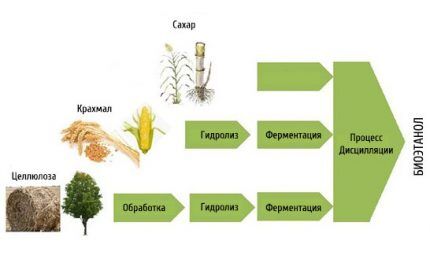
The situation with ethanol biofuel is somewhat different. It is produced on a much smaller scale. This is mainly done in Europe, but Russia also has its own factories.To produce this biofuel, raw materials of plant origin are also needed, but not in such huge volumes as in the case of the automobile analogue.
In domestic stores, you can choose fireplace biofuel from the following brands:
- Kratki BioDECO (Poland).
- InterFlame (Russia).
- BioKer (Russia).
- Planika Fanola (Germany).
- Vegeflame (France).
- Bionlov (Switzerland).
- Bioteplo Slimfire (Italy).
The choice is quite extensive. The price per liter ranges from 260–600 rubles. Cost often depends on the presence/absence and combination of additional additives. Some aromatic oils are quite expensive. Although they are present in biofuels in very small proportions, they still affect the price.
Self-made fuel
To produce ethanol, the basis of biofuel, on an industrial scale, hydration (hydrolysis) or fermentation technologies are used. In the first case, alcohol is obtained from cellulose. Straw or wood are used as raw materials.
The second option involves microbiological fermentation of organic matter under the influence of bacterial and yeast enzymes. The raw materials in such industries are raw sugar, starch, rice, corn, grapes, etc.
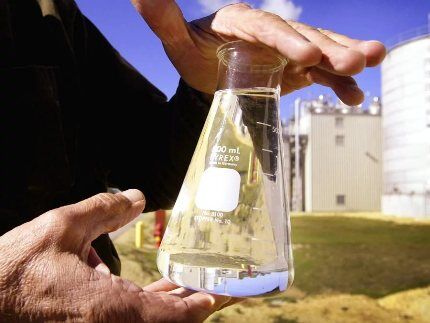
Making ethyl alcohol yourself by fermentation or other means at home is a thankless, difficult and expensive task. It's easier to go and buy it in its pure form at the pharmacy. For biofuel production it is needed without additives or impurities. It is almost impossible to achieve the required concentration and cleanliness at home without a chemical laboratory.
To make 1 liter of biofuel for your fireplace yourself, you will need:
- liter of medical alcohol 96 degrees;
- 50–10 ml of purified gasoline (as in lighters).
Ideally, the second component should be transparent and odorless. It is needed to give the resulting fuel an orange tint to the flame. Gasoline is also required so that the alcohol does not burst into flames all at once when set on fire, but then burns with an even flame.
It is best to mix the composition immediately before pouring it into the bio-fireplace tank. The liquids used in the independent production of fireplace fuel have different densities.
If you leave them for several hours after preparing the mixture in any container, they will begin to separate. Gasoline will separate from the alcohol and turn into a film floating separately in it.
When using such homemade biofuel, a slight alcohol smell may appear in the room. It is difficult to get drunk or poisoned by it.
Plus it fades quickly. But the “aroma” of alcohol causes unpleasant associations for many. To get rid of this amber, add a few drops of one or another aromatic oil to the fuel when mixing.
Conclusions and useful video on the topic
Video #1. How to pour fuel into a biofireplace:
Video #2. The simplest table candle-fireplace using biofuel:
Video #3. Making your own fuel for a biofireplace - from rectifying alcohol to mixing with gasoline:
A small bio-fireplace can be installed both in an apartment and an office. It is safe and will enliven any interior. When choosing liquid fuel for it, the main attention should be paid to the availability of certificates from the seller for specific products.
All these liquids have almost the same composition.They differ only in aromatic additives. Therefore, the main thing is that the alcohol must be of high quality and pure, and not a fake with a bunch of harmful impurities.
Please write comments in the block below. Tell us about the type of fuel you choose for your compact fireplace and how you use it. Ask questions, share useful information for visitors, post photos related to the topic of the article.




For a bio-fireplace, bioethanol is the best thing, pour it in and that’s it. Every time we buy a canister with a different color of flame, it turns out interesting and doesn’t get boring. But they took the flavored one only once, it turned out that they were in a room of 18 square meters. m. is impossible in half an hour, and there is no talk of sleep, so he stands there in the hope that things will go better at the dacha, there is a larger room where it might not be so suffocating.
I have always dreamed of having a real wood-burning fireplace in my own home. But my husband bought an apartment, so I had to look for a bio-fireplace. It runs on liquid fuel and does not require additional elements. The fireplace can easily be moved to another room. At one time the smell bothered me, they changed the scent and began to ventilate the apartment more often. The most important thing is that the biofireplace is completely safe.
I also have a problem with the strong unpleasant odor emitted by burning biofuel. Are there any ways to get rid of it other than using a hood? As far as I understand, it is not the ethanol itself that smells, but the additives that interfere with it for color. Is there a brand without a scent?
Effect on the body
A concentration in the air of one milligram is enough for a person to experience severe irritation in all mucous membranes (eyes, nose and throat) within three minutes.